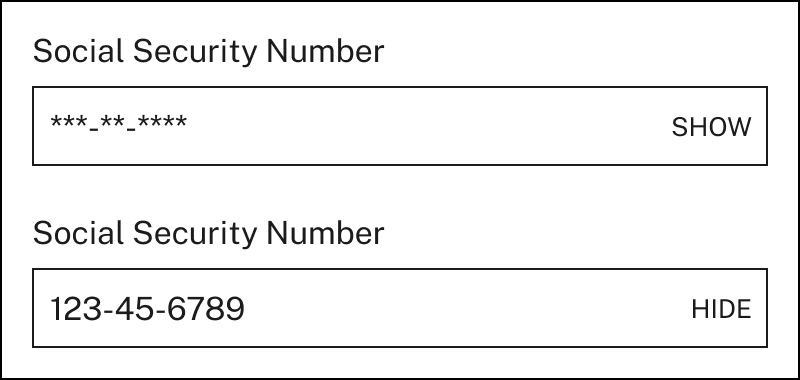Accurately entering personal information on the initial UI application can prove challenging for some individuals, especially when they encounter name fields, address formats, or personal identification requirements that are not inclusive of the variety of ways in which people may identify themselves.
Recommendation 1: Support individuals in accurately representing themselves during the online application process
Some individuals are unable to progress past the very first step of the initial application because the design of the answer fields does not permit them to successfully enter their names. Certain question/answer formats prevent individuals from accurately entering the information requested while others can’t move forward with their application because the automatic checks used in the online system assumes certain names have been entered incorrectly (e.g., names that are too short or contain special characters). Facing these obstacles during the application process can create an unnecessarily stressful experience and prompt some individuals to potentially abandon the application altogether.
Provide an inclusive way for individuals to enter their names
Related CX principle: Design for equitable access and inclusivity
- Allow individuals to enter names that have up to 128 characters or that are as short as a single character.
- Allow hyphens, apostrophes, blank spaces, and special characters in each name field.
- In cases where an individual’s name is too long, too short, or contains special characters, consider displaying a confirmation message to check that the information entered is correct instead of preventing individuals from moving forward with the application. Refer to the example.
These recommendations are also described in additional detail in the United States Web Design System (USWDS) guidance for name fields..

Offer contextual help to individuals when using name fields
Related CX principle: Provide contextual help
Use help text to guide individuals on how to enter their names (e.g., middle name, middle name initials only, or the letters “NMN” if the individual does not have a middle name) or to specify what types of names they should enter (e.g., legal name only or legal name and optional chosen name). Note: A chosen name may not take the place of a legal name. The chosen name field must be optional and used only in addition to the required field for legal name. Consider using the autocomplete attribute with name fields to allow the browser to autofill information that has previously been entered by the individual. Refer to the examples provided.

Recommendation 2: Help individuals accurately enter their address by incorporating features that minimize human error
Related CX principles: Pre-populate where possible; Provide contextual help
Collecting correct address information from individuals is essential to ensure accurate application processing and timely follow-up communication. States can help individuals avoid input errors or formatting issues when entering their address by implementing the following best practices.
- Minimize individuals’ workload and potential typos by allowing them to use the autocomplete attribute of the browser when this information has already been entered and saved by the individual.
- Include additional functionality for the address field so that it auto-fills the address according to what the individual is typing (e.g., search-as-you-type address lookup). Refer to the example provided.

- Provide a check and validation for the address format. If necessary, suggest that individuals correct the address provided. This suggestion should appear as an alert and must not prevent individuals from moving forward with their application. Refer to the example provided.

- Provide an optional “in care of” field so individuals can enter special mailing instructions, such as the name of a person receiving mail on their behalf or other specific delivery instructions for the postal worker. Refer to the example provided.
- Add a checkbox feature to ask individuals to confirm if their mailing address is the same as their residential address. Refer to the example provided.
To learn more about collecting address information, review the USWDS guidance for address fields.

Recommendation 3: Provide specific guidance to individuals when referring to personal identification documentation or work authorization documents so they can find the information they need to complete the application
Related CX principle: Plain language; Provide contextual help
Some individuals completing the initial application come to a standstill when asked to refer to personal identification documentation or work authorization documents. Many don't understand what documentation information to include or have difficulty finding the information they need on the specified document. The recommendations below can help guide individuals who struggle with this part of the initial application.
- Provide sample images of the physical documents showing where claimants can find the required information (e.g., document number, expiration date). The sample images should show what the document looks like, where to find the required information on the document, and what information should be entered (e.g., driver’s license, license number, and license expiration date). Refer to the example provided.

- Add instructions as to how the information should be entered. For example, provide help text on what format to use (e.g., ###-####) or which characters should be included (e.g., only numbers, letters, a combination of letters and numbers, special characters).
- If using masks to protect the individual’s privacy (such as asterisks), add a button to toggle between showing and masking the characters. Refer to the example provided.

- Provide a broad list of categories when asking about work authorization so individuals can easily select an accurate description of themselves. Refer to the example provided.
- Consider including help text to provide additional context for each category.
Sample citizenship question
Are you legally allowed to work in the United States?
- Yes; I am a U.S. citizen
- Yes; I am a permanent resident (green card holder)
- Yes; I have an employment authorization card/document
- [Include other examples as allowable under state law]
- No; I am not legally allowed to work in the United States
- I don’t know
